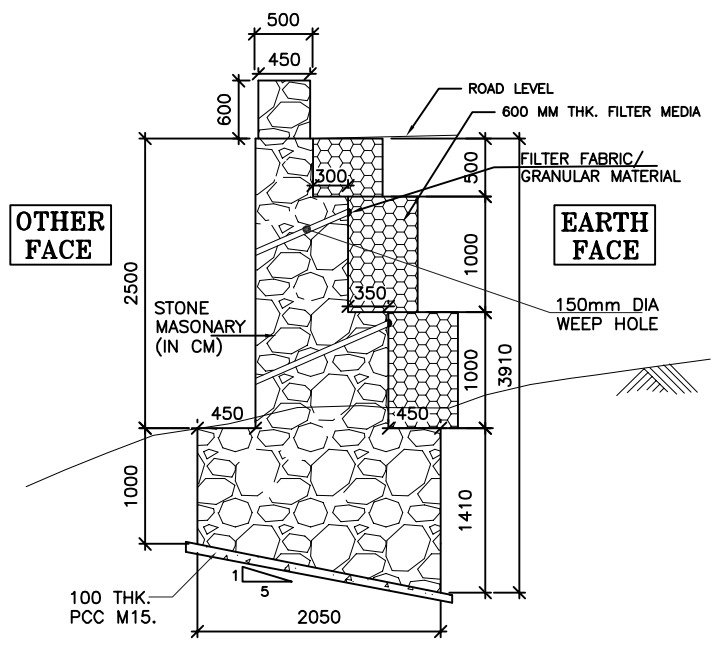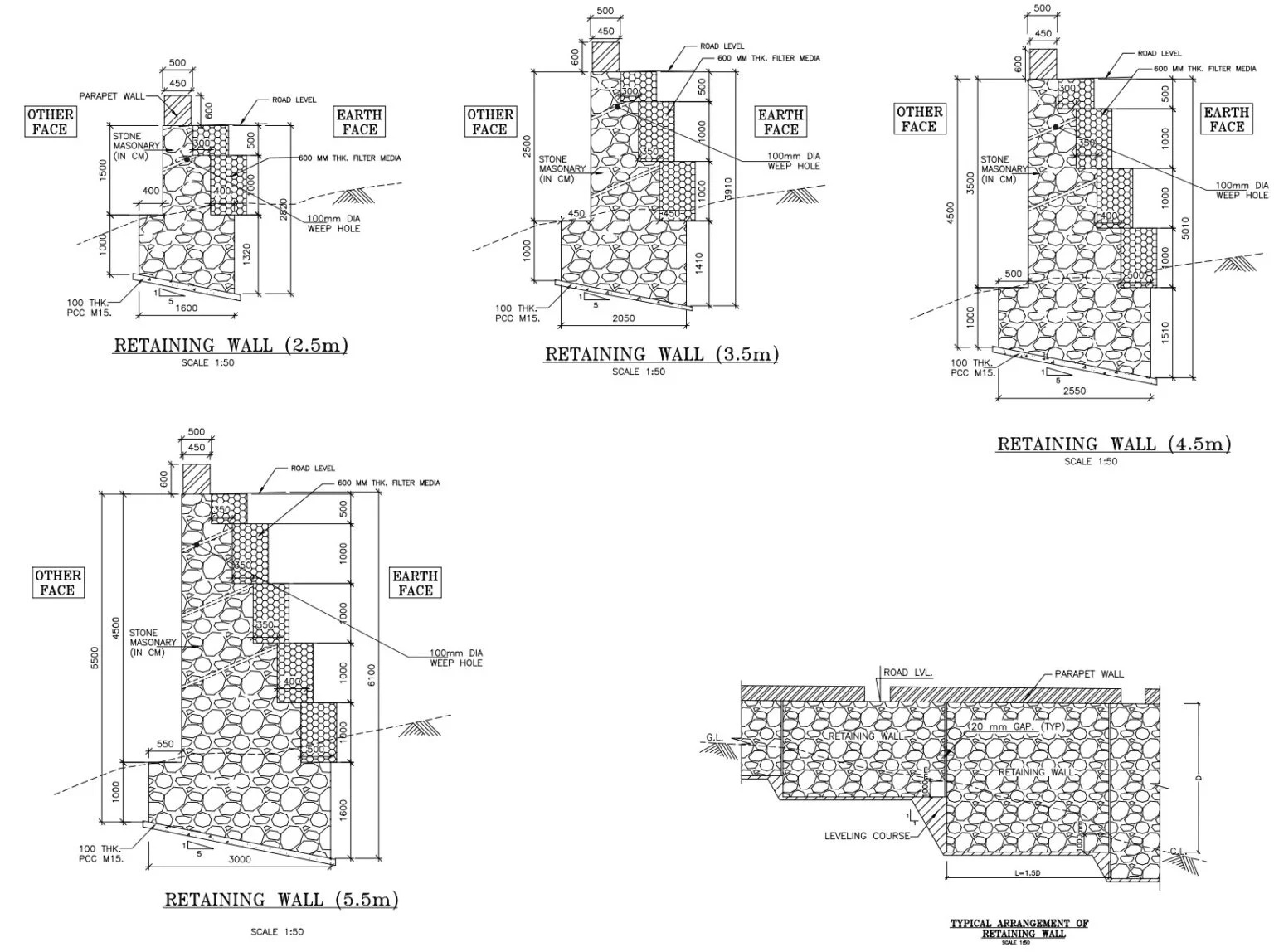Retaining walls represent important structures in civil engineering and landscaping, designed to use soil or other materials, preventing erosion and collapse. Their significance extends to creating terraces, leveling slopes and stabilizing uneven terrain. When it comes to retaining walls, a spectrum of different types exist, each distinguished by unique features and benefits. This exploration explores several Types of Retaining wall in Civil Engineering and difference between them, focusing on their structural properties and applications:
- Gravity Retaining Walls
- Cantilever Retaining Wall
- Sheet pile Retaining Walls
- Anchored Walls
- Gabion Retaining Walls
Table of Contents
1. Gravity Retaining Walls

Gravity retaining walls rest on their internal weight to resist the pressure exerted by the soil they hold. Usually constructed from concrete or stone, these walls find suitability for heights up to 6m. The underlying mass of the structure provides stability, effectively preventing soil movement. A fundamental reliance on gravity distinguishes this type, making it a simple yet powerful solution for medium retaining wall needs.
2. Cantilever Retaining Wall
Cantilever retaining walls present a more sophisticated design, characterized by reinforced concrete structures. The configuration involves a horizontal base slab and a vertical stem, with components strategically designed to withstand soil pressure. With a distinct backward-inclined stem and a base slab embedded in the soil, this type allows the weight of the soil to counterbalance the pressure exerted by the retaining material. Cantilever retaining walls exemplify precision in engineering, effectively coordinating structural elements to achieve stability.
3. Sheet pile Retaining Walls
Sheet pile retaining walls depart from traditional solid structures, opting for laminated steel, vinyl, or wood planks as the primary building material. These planks are forced into the soil, creating a barrier that perfectly holds the soil and reduces erosion. This type proves particularly effective in confined spaces, demonstrating versatility by accommodating both temporary and permanent applications. The simplicity of sheet pile design belies its effectiveness in providing structural integrity while accommodating spatial constraints.
4. Anchored Walls
Anchored retaining walls introduce a dynamic element into the structural equation by incorporating cables or rods anchored into the soil or rock behind the wall. This additional reinforcement serves to prevent potential overturning or sliding, especially in situations with high loads or considerable wall height. Strategic integration of anchors increases the overall stability of the retaining wall, making it a preferred choice for projects with specific structural needs.
5. Gabion Retaining Walls
Gabion retaining walls deviate from traditional materials, using wire baskets or cages filled with rock, stone or alternative materials. These baskets are systematically stacked to form a flexible yet resilient wall capable of withstanding soil pressure. The flexibility of gabion walls extends beyond their structural elements, allowing natural drainage and promotion of vegetation growth. This adaptability positions gabion retaining walls as a harmonious blend of structural soundness and environmental compatibility.
SUMMARY
As varied as these retaining wall types are, choosing the most appropriate one for a project depends on several important factors. Elevation considerations, soil texture, aesthetic preferences, and budget constraints collectively influence the decision-making process. A prudent approach involves consulting with professional engineers or contractors, ensuring a broad understanding of project-specific needs, and implementing a retaining wall design consistent with those needs.
Height Considerations
The height of a retaining wall plays an important role in determining the most suitable type. Gravity retaining walls, for example, excel in applications not exceeding 3 feet in height. Beyond this threshold, other types, such as cantilever or anchored walls, may be more suitable due to their improved structural reinforcement capacity. Understanding the vertical needs of the project is paramount to making an informed choice.
Soil Composition
The prevailing soil type in the project area significantly influences the selection of a retaining wall type. Gravity walls, depending on their weight, are suitable for cohesive soils, while cantilever walls, with their strategic design, can accommodate a variety of soil types. In areas with limited space or challenging soil conditions, sheet pile walls may emerge as the preferred option, providing a practical solution for soil retention.
Aesthetic Choice
In addition to their functional role, the visual aspect of retaining walls is gaining recognition in landscaping and architectural spheres. Gravity walls, characterized by their solid and monolithic appearance, complement traditional or formal aesthetics. Conversely, gabion walls seamlessly integrate with the environment, offering a natural and textured visual appeal. The choice between these aesthetic options often depends on the overall design vision and desired visual impact on the landscape.
Budget Constraints
Money matters in construction, even when it comes to building retaining walls. Gravity walls can be a wise choice for projects with limited funds because of how easy they are to design and assemble. However, you may have to pay extra money if you’re going for something fancy, like cantilevered or anchored walls. It all comes down to finding the ideal balance between your budget and the desired level of wall sturdiness. That’s the secret to finding a workable solution at an affordable price.
While these factors provide a framework for decision making, the complexities of retaining wall projects require professional guidance. Engaging experienced engineers or contractors ensures a comprehensive assessment of site-specific conditions and facilitates the selection of an optimal retaining wall type.
SUMMARY
Professional advice becomes particularly relevant during the design and construction stages. Engineers use their knowledge of drainage considerations, structural calculations, and soil analysis to solve a variety of problems. Their observations are invaluable in creating a thorough understanding of the site and in directing the construction of retaining walls that satisfy structural specifications and are in line with long-term sustainability and performance goals
Retaining Wall Design as per IS code
The IS (Indian Standard) Code, namely IS 3370 Part 2: 2019 – Code of Practice for Concrete Structures for the Storage of Liquids, establishes requirements that retaining walls must meet. In order to guarantee the stability, safety, and structural integrity of retaining walls under varied loading scenarios, specific requirements must be followed.
1. Site Investigation
Before building a retaining wall, it’s important to learn about the soil, how much water is underground, and other stuff about the ground. This helps figure out how strong the soil is and how much sideways pressure it might put on the wall.
2. Structural Analysis
When planning a retaining wall, engineers study how much force and pressure it’ll face. They do this by looking at things like how much the soil pushes against it, the weight of any water, extra loads on top, and even earthquakes.
3. Types of Retaining Walls
When designing a retaining wall, engineers consider different types, like ones that rely on their weight (gravity walls), ones that stick out from the ground (cantilever walls), ones with extra support (counterfort walls), and ones anchored into the ground. The type chosen depends on how tall the wall needs to be, what the soil is like, and how much pressure it’ll face.
4. Stability Analysis
Evaluating sliding stability, overturning stability, and bearing capacity to ensure the wall can withstand loads and maintain stability over its lifespan.
5. Structural Design
The structural design process includes establishing the dimensions and reinforcement specifics of the retaining wall elements. The IS Code offers guidelines for factors such as wall thickness, toe and heel dimensions, reinforcement detailing, and minimum safety factors.
6. Drainage Considerations
Incorporating drainage features like weep holes to prevent water accumulation behind the wall and minimize hydrostatic pressure.
7. Earthquake Considerations
When designing a structure like a retaining wall in an area where earthquakes happen, engineers make sure it can handle the shaking. They follow rules about how strong it needs to be (seismic coefficients) and specific ways it needs to be built to withstand earthquakes.
8. Material Specifications
Ensuring materials used meet IS Code specifications, including concrete, steel reinforcement, and additional construction materials.
9. Construction Guidelines
Following recommended construction practices to ensure the wall is built as per design, crucial for its intended performance and longevity.
SUMMARY
Following the IS Code is super important for making sure retaining walls are safe, strong, and last a long time. It’s crucial to talk to engineers who know the IS Code well and stay up-to-date with any changes. This helps ensure that the retaining wall is built right and meets all the rules for safety and quality.
Causes of Failure of Retaining Wall
Because retaining walls are specifically designed to withstand the sideways pressure of water or soil, they maintain stability even in situations where the land slopes. However, they can fail for a variety of reasons, and this can occur sometimes. Understanding these reasons really well is crucial for making sure we design, build, and take care of retaining walls properly. Here are some common causes of retaining wall failure:
Poor Drainage
Water that collects behind a wall experiences tremendous pressure from the absence of any openings or escape channels, which can undermine the wall and cause it to tilt, break, or even collapse entirely.
Inadequate Design
A retaining wall has a higher chance of failing if it is poorly design. This mishap happens when crucial elements including the kind of soil, the volume of groundwater, and the anticipated weight on the wall are not taken into consideration during the designing process. The wall construction can become weaker and more prone to collapsing due to issues like not applying enough reinforcement, making the wall too thin, or neglecting excess weight on top.
Soil Erosion
Because retaining walls are frequently exposed to the elements, soil erosion may eventually happen. The wall’s stability is reduced when the earth erodes, which could result in failure. Vegetation growth on the wall can contribute to erosion and should be carefully managed.
Overloading
Excessive loads or surcharge loads applied to the retaining wall, beyond its design capacity, can result in failure. This can occur due to poor construction practices, changes in land use, or additional loads placed on the wall after its initial construction.
Settlement
If the ground underneath a retaining wall settles unevenly, it can cause the wall to move in different ways. This can make the wall tilt, develop cracks, or even bulge out. These changes can weaken the wall and make it less stable over time.
Earthquake Forces
To survive seismic activity, retaining walls must be built with considerable strength. They may fail during an earthquake if they are not designed to resist the side-by-side vibrations caused by earthquakes.
Material Deterioration
Concrete and steel, which are typically used to build retaining walls, can deteriorate over time when exposed to the elements. This can cause the steel reinforcements to corrode or the concrete to erode, making the wall less strong and more likely to break.
Lack of Maintenance
Maintaining retaining walls and addressing concerns as they arise is crucial to their long-term viability. If we do not inspect them on a regular basis for problems such as erosion, cracks, and drainage, these issues may grow with time and eventually lead to the wall’s collapse.
Poor Construction Practices
It’s critical to construct retaining walls correctly. If the relevant engineering principles and processes are not followed, the wall may become less stable and more prone to failure, such as ensuring that the ground is properly packed down, adding reinforcement in the appropriate spots, or taking shortcuts when building.
SUMMARY
A complete approach is required to ensure that retaining walls do not collapse. This includes properly evaluating the location, carefully planning the wall’s design, using quality construction procedures, and closely monitoring the wall after it is erected. Having knowledgeable engineers is critical to ensuring that the wall can resist any difficulties it faces. Routine inspections and rapid repairs are required to ensure the wall’s safety and lifespan.
Function of Weep hole in Retaining Wall
A retaining wall’s weep hole is an important part of its construction because it controls water buildup and pressure behind the wall. Weep holes are critical for the long-term stability and structural integrity of retaining walls, which are designed to hold soil back and prevent erosion.
Weep holes are tiny holes or perforations that are deliberately positioned along a retaining wall’s base. Their main function is to make it easier for water that may collect behind the wall from irrigation, rainfall, or other sources to drain. Weep holes help to release hydrostatic pressure, which otherwise builds up and exerts stress on the wall by enabling water to escape.
The key functions of weep holes in a retaining wall include:
Water Drainage
Weep holes serve as small escape pathways for water that could otherwise become trapped behind a retaining wall. To prevent pressure from building up, which could otherwise result in major issues like the wall crumbling, bending, or developing cracks, it is crucial to have enough drainage.
Pressure Relief
The retaining wall is under pressure from the accumulation of water in the soil behind it. Weep holes ease the stress on the wall by allowing water to escape, acting as tiny pressure release valves. This keeps the wall stable and strong over the long haul.
Prevention of Soil Erosion
Having good drainage through weep holes stops soil erosion from happening behind the wall. Too much water can soak the soil, making it unstable and prone to erosion. Weep holes make sure the water drains away, which helps keep the soil stable and prevents erosion from occurring.
Prevention of Wall Damage
If water gets stuck without a way out, it can cause problems, especially in colder places where it might freeze. This freezing and thawing cycle can damage the wall. Weep holes prevent this by letting the water out, so there’s no risk of the freeze-thaw cycle messing up the wall.
SUMMARY
It’s crucial to remember that elements like the kind of retaining wall, the wall’s height, the state of the soil, and the expected water load affect the size and spacing of weep holes. To guarantee maximum functionality, weep holes should be placed carefully during the design and construction phases.
Lateral Earth Pressure on Retaining Wall
In geotechnical engineering, the lateral earth pressure—which is the force per unit length that the retained soil applies horizontally against a retaining wall—is an important factor to take into account. This pressure, which arises from the soil’s innate tendency to seek equilibrium, is important to consider while designing and analyzing retaining walls.
The type, density, and geometry of the wall are some of the variables that affect the lateral earth pressure. Theories like Coulomb’s Earth Pressure Theory and Rankine’s Earth Pressure Theory, which both offer frameworks for calculating the magnitude and distribution of these lateral forces, are often used to assess the application of lateral earth pressure against the retaining wall.
All in all, lateral earth pressure must be precisely understood and calculated in order to create retaining walls that can withstand loads and remain stable. A thorough examination of lateral earth pressure is ensured by taking into account variables such as soil qualities, groundwater conditions, and probable surcharge loads. This eventually contributes to the retaining wall’s structural integrity and lifetime.
Conclusion
In conclusion, the field of retaining walls encompasses a variety of diverse configurations, each tailored to specific needs and conditions. From the simplicity of gravity walls to the sophistication of cantilever structures, the choice involves a brief evaluation of project-specific factors. Elevation, soil texture, aesthetic preferences, and budgetary considerations collectively shape the decision-making process. Professional advice emerges as a key enabler, ensuring that the chosen retaining wall type is compatible with the complexity of the site and stands as evidence of structural integrity and aesthetic sensibility. If you want to more about the retaining wall then stay with us in our website https://prewallcivil.com.
Frequently Asked Questions
How to calculate slope of Retaining wall?
To calculate the slope of a retaining wall, use the formula: Slope = Rise/Run. Measure the vertical distance (rise) and the horizontal distance (run) along the base. Divide the rise by the run to determine the slope ratio. For example, a 1:3 slope means the wall rises 1 unit for every 3 units along the base.
Why shear key is provided in Retaining wall?
A shear key in a retaining wall is provided to enhance stability by preventing sliding along the base. It increases resistance to lateral forces from retained soil. This key, often excavated into the foundation soil, reduces the risk of wall movement, ensuring long-term structural integrity and performance.
What is Backfill in Retaining wall?
Backfill in a retaining wall refers to the material placed behind the wall structure. This soil or other material provides support, stability, and counteracts the lateral pressure exerted by retained earth. Properly compacted backfill is essential for the overall effectiveness and longevity of the retaining wall.
What is surcharge in Retaining wall?
A surcharge in a retaining wall context refers to an additional load imposed on the wall due to external factors like buildings, structures, or stored materials near or on the wall. It influences the lateral earth pressure and must be considered in the wall’s design to ensure stability.
Why weep holes are provided in Retaining wall?
Retaining wall weep holes are essential because they let water escape from behind the wall and stop hydrostatic pressure from building up. Potential problems including frost damage, soil erosion, and the unstable effects of water accumulation are lessened by this drainage. In regions where water retention is common, weep holes are particularly important for preserving the long-term stability and structural integrity of retaining walls.

